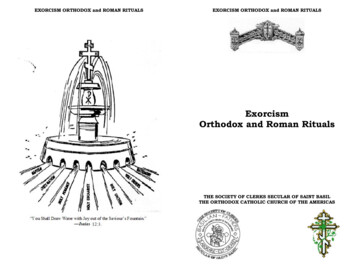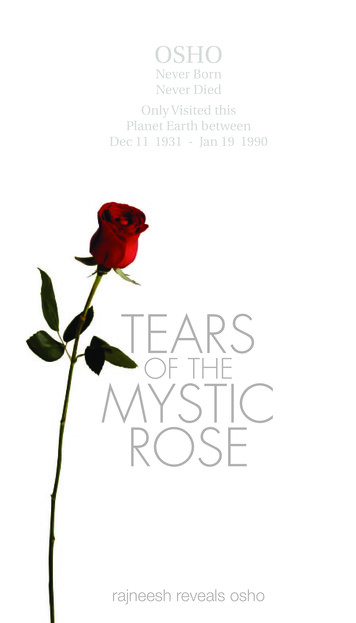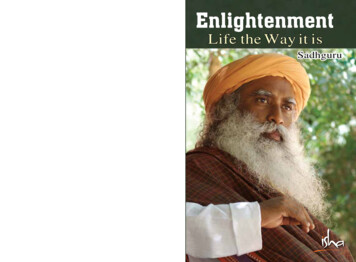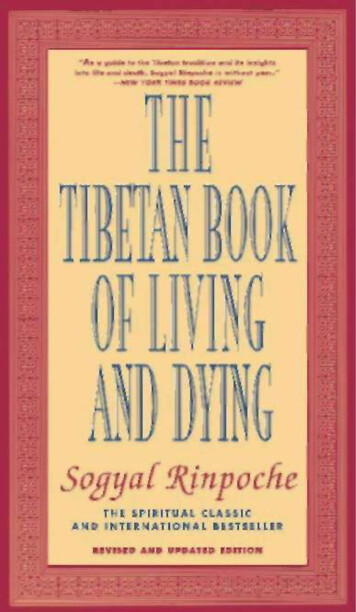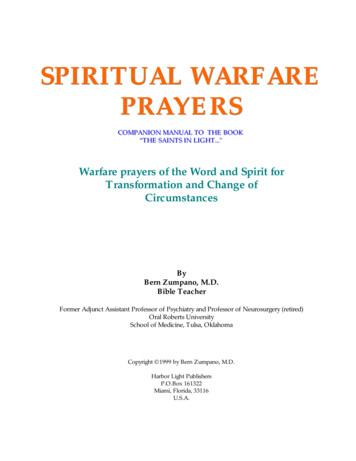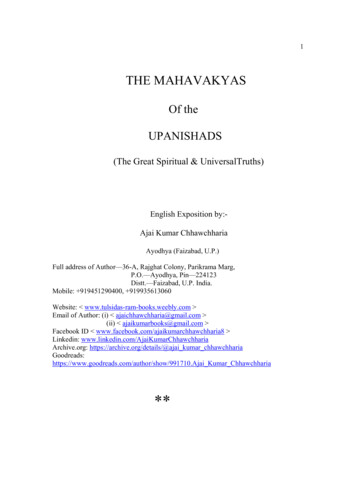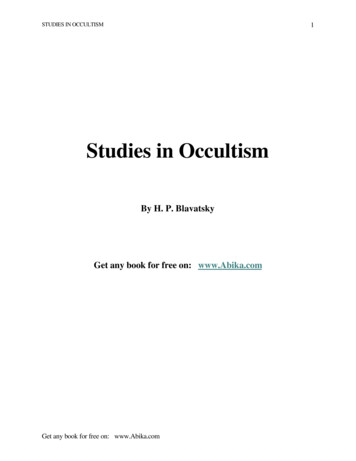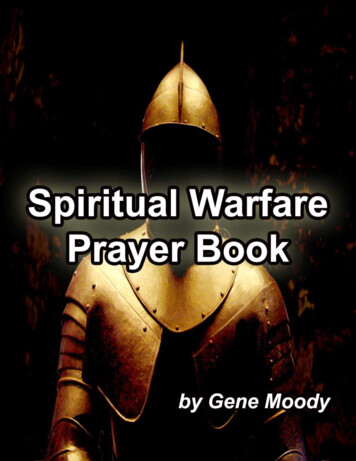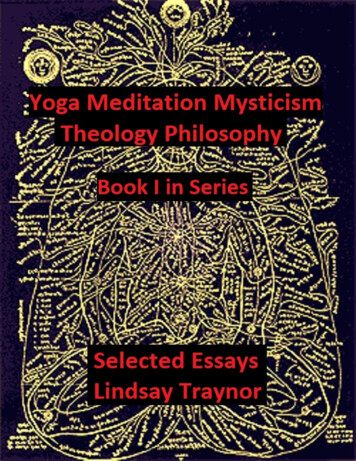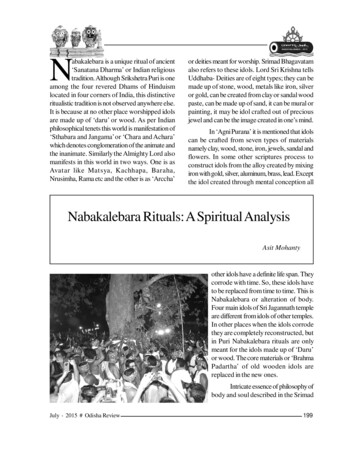
Transcription
Nabakalebara is a unique ritual of ancient‘Sanatana Dharma’ or Indian religioustradition. Although Srikshetra Puri is oneamong the four revered Dhams of Hinduismlocated in four corners of India, this distinctiveritualistic tradition is not observed anywhere else.It is because at no other place worshipped idolsare made up of ‘daru’ or wood. As per Indianphilosophical tenets this world is manifestation of‘Sthabara and Jangama’ or ‘Chara and Achara’which denotes conglomeration of the animate andthe inanimate. Similarly the Almighty Lord alsomanifests in this world in two ways. One is asAvatar like Matsya, Kachhapa, Baraha,Nrusimha, Rama etc and the other is as ‘Arccha’or deities meant for worship. Srimad Bhagavatamalso refers to these idols. Lord Sri Krishna tellsUddhaba- Deities are of eight types; they can bemade up of stone, wood, metals like iron, silveror gold, can be created from clay or sandal woodpaste, can be made up of sand, it can be mural orpainting, it may be idol crafted out of preciousjewel and can be the image created in one’s mind.In ‘Agni Purana’ it is mentioned that idolscan be crafted from seven types of materialsnamely clay, wood, stone, iron, jewels, sandal andflowers. In some other scriptures process toconstruct idols from the alloy created by mixingiron with gold, silver, aluminum, brass, lead. Exceptthe idol created through mental conception allNabakalebara Rituals: A Spiritual AnalysisAsit Mohantyother idols have a definite life span. Theycorrode with time. So, these idols haveto be replaced from time to time. This isNabakalebara or alteration of body.Four main idols of Sri Jagannath templeare different from idols of other temples.In other places when the idols corrodethey are completely reconstructed, butin Puri Nabakalebara rituals are onlymeant for the idols made up of ‘Daru’or wood. The core materials or ‘BrahmaPadartha’ of old wooden idols arereplaced in the new ones.Intricate essence of philosophy ofbody and soul described in the SrimadJuly - 2015 # Odisha Review199
Bhagavad Gita is the foundation of Nabakalebararitual of Sri Jagannath.Essence of the Gita in Nabakalebara‘Kalebara’ or body has been describedas ‘agamapayi’ or that manifests and vanishes.Body gets created and also gets destroyed. But‘Atma’ or soul remains intact as it is indestructible.It is eternal. In this context there is a much quotedsloka in second chapter of the Gita knows asSankhya Yoga, “Basamsi Jirnani ”. In 1951,Dasarathi of Sambalpur had translated thisfamous sloka in nine syllable Odia poetic rhythm,“Tejina puruna basana, pindhila parayenutana, e jirna deha chhadi dei, nutana dehadhare dehi”. When worshipped in this world as‘Devata’ Sri Jagannath as an idol is also ‘Dehi’ orholder of a body. So, Sri Jagannath also shedsoff His worn out body to take up a new one.Nabakalebara is a practical demonstration of thistheory depicted in the Gita.Meaning of Kalebara‘Kalebara’ means body. There areseveral other Indian synonyms for it including‘sharira’, ‘deha’ and ‘bapu’. The question isdespite availability of several words why the word‘kalebara’ has been choosen for Nabakalebararitual? Deeper etymological analysis hints that‘sharira’ denotes that which corrodes. Whichshows signs of growth or ‘upachaya’ is ‘deha’and that which is capable to sow seed of life is‘bapu’. Meaning of ‘Kalebara’ is etymologicallydifferent from these words. Experts say‘Kalebara’ word has emerged from ‘kale sukrevaram sreshtham’. Former Sanskrit Professorof Utkal University in his article in the July 2015edition of the ‘Pourusha’ has said, “That which isbest in ‘kale’ or as per essence of life is‘Kalebara’. It is a synonym of the body whichdenotes the period when ‘sukra’ or essence oflife is at its paramount state.200Indian philosophy says our body isconstructed of seven ‘dhatu’ or basic materials.‘Sukra’ is most subtle and powerful among them.‘Saptadhatu’ or seven core materials include‘rasa, asruk, mansa, meda, asthi, majja andsukra’. The body in which ‘kale’ or ‘sukra’ ispowerful and strong is ‘kalebara’. The principleof ‘Basamsi jirnani ’ of the Gita does not gowith this. It hints that ‘nabakalebara’ is a ‘leela’or play of Sri Jagannath. Idols of Sri Jagannathtemple are not reconstructed because ofdeterioration of ‘kalebara’; but through this‘leela’ the cycle of birth and death in this mortalworld are depicted. It shows that there is noreason of fear for death in this mortal world. Bodythat has manifested is sure to get destroyed. Itwill come and go. This is the verity of existence.Basis of Daru or wooden idolScriptures indicate that earlier idol of SriJagannath was ‘manimayi’ or crafted out of aprecious jewel. Nilamadhav worshipped bySabara community or tribals before advent ofworship of Sri Jagannath was an idol of this kind.But historians like Satyanarayan Rajguru opinethat earlier idol of Sri Jagannath was made up ofstone. But ‘Skanda Purana’ and ‘SaralaMahabharata’ say when the idol made up ofIndranilamani (Indranila jewel) vanished, the Lordappeared in the form of divine ‘daru’ or as awooden log. New idols were prepared from thisdivine log, say these scriptures. ‘Skanda Purana’further mentions that the Lord has taken the formof ‘daru bigraha’ or wooden idol in holy andenlightening Purushottam Kshetra as part of aleela for the humans.Chaitanya Charan Das in his translationof ‘Skanda Purana Purushottama Mahatmya’ hasdescribed the word ‘daru’ to be derived fromtwo Sanskrit roots; one is ‘daa’ and the other is‘do’. ‘Da’ means ‘darana’ or to cut and ‘do’Odisha Review # July - 2015
means to give. The Lord slashes away all oursorrows and provides infinite bliss and happiness,so He has taken the form of ‘daru bigraha’ aspart of His ‘leela’ among the humans. As part ofthis ‘leela’ He takes up new ‘kalebara’ at definiteintervals. Collection of ‘daru’ and constructionof idols are done through His subtle directives.Thought behind AgnyamalaRituals of Sri Jagannath’s Nabakalebarabegin with ‘Agnyamala’. As per the tradition onChaitra Shukla Dasami day of Indian calendar,four ‘agnyamala’ are received from the deitiesSri Jagannath, Sri Balabhadra, Devi Subhadra andSri Sudarshan to start the search of ‘daru’ forNabakalebara.Senior servitor of Sri Jagannath temple,Rabindranath Pratihari in his book‘Sridarubrahmanka Agnyamala Rahasya’ haselaborated this word. According to him, thiscompound word has been formed from twoSanskrit words ‘Agnya and mala’ that have beenjoined through ‘karmadharaya samasa’. He says‘Agnya’ is ‘mala’ and ‘mala’ is ‘Agnya’. Odiadictionary ‘Purna Chandra Odia Bhasakosha’mentions- As a mark of order of any deity thegarland of flower sent to the person who will dothe job is called ‘Agnyamala’. It also meansgarland used by the deity. This garland of floweris revered as order or directive of the deity.This ‘Agnyamala’ tradition of SriJagannath temple has scriptural and spiritual basis.It is believed that Almighty God despite being the‘kartta’ or ultimate doer is only the ‘sakshipurusha’ or witness. He is also ‘akartta’; Henever does anything but everything in this universehappens as per His directive. As ‘sakshi purusha’He only silently witnesses everything. So, He is‘Jagat Chakshu’ or eye of the universe. So, Hehas large round eyes devoid of eyelids. So, allJuly - 2015 # Odisha Reviewactions in this world are offered to Him withoutany desire for their outcome.In the above mentioned book MrPratihari has mentioned 139 known and unknown‘agnyamala’ of Sri Jagannath temple. In theglossary of the book, he has provided a list of 39kinds of animate, inanimate and ‘chalantipratima’ or proxy-idols, who take part in variousfestivals after getting ‘Agnyamala’. As per this listthere are 27 such ‘chalanti pratima’ or proxyidols and the number of animate and inanimateentities is eight. The person who dons the garb ofRavana for the ‘Ravana Vadha’ celebrations ofBali Sahi on Baisakha Krushna Dwitiya gets the‘agnyamala’ touched to the ‘ratnasimhasana’or altar of Sri Jagannath temple. For thecoronation ceremony or ‘abhishek utsav’ on theSri Ram Navami day, the ‘ratnapaduka’ of SriRam is provided a ‘agnyamala’. The rest sixtimes ‘agnyamala’ is given for ‘daru’ meant forNabakalebara as well as to the three chariotsmeant for annual Rathayatra. Four ‘agnyamala’are accepted by respective ‘badagrahi’ for idolsof Sri Jagannath temple on Chaitra ShuklaDasami. ‘Badagrahi’ denotes leader of a segmentor ritualistic group responsible for the particulardeity or chariot.Analysis of agnyamala given to daruAs per the traditional rituals, after the‘madhyanha dhupa’ or food offering of mid-dayon Chaitra Shukla Dasami, servitor PatiMohapatra, who is believed to be descendant ofVidyapati collects four ‘agnyamala’ used on theidols of Sri Jagannath, Sri Balabhadra, DeviSubhadra and Sri Sudarshan. Three of these arehanded over to three respective ‘Badagrahi’ ofSri Jagannath, Sri Balabhadra and Devi Subhadra,who are Daitapati servitors. Pati Mohapatra keepsthe ‘agnyamala’ of Sri Sudarshan with him. Heserves as the ‘Badagrahi’ of Sri Sudarshan.201
Most important point to note is that afteridentification of trees meant to become ‘daru’,these four ‘Agnyamala’ are offered to respectivetrees. The ‘Agnyamala’ of each idol is offered tothe tree from which the same idol is to beconstructed. It means the ‘Agnyamala’ providedto three ‘Badagrahi’ and Pati Mohapatra are notmeant for these servitors. They are for the neemtrees which are to be chosen. These four‘agnyamala’ are transported to Deuli Math atKakatpur by a bullock cart. One after another,four ‘daru vriksha’ or trees meant to be ‘daru’are chosen and respective ‘agnyamala’ are offeredto these trees. The message behind it is thatidentification and location of ‘daru vriksha’ forNabakalebara is not done by the servitors whoreceive the ‘agnyamala’ or their associates. SriJagannath chooses the ‘daru’ for His ownNabakalebara. Concerned Daita and PatiMohapatra servitors take part in this wholeprocess only as carriers or couriers of‘agnyamala’.Chakraraj and Chakranarayana philosophyAfter getting ‘agnyamala’, the team of‘darujatri’ or explorers of ‘daru’ come out ofthe temple through its Singhadwara and travel toSri Jagannath Ballav Math via the Sri Nahar orroyal abode of Gajapati Maharaja, the king ofPuri. From there they travel to Deuli Math atKakatpur. During this journey Sri Sudarshan leadsthe way. This Sudarshan is not the pole like oneworshipped on the ‘ratnasimhasana’. It is areplica of the Nilachakra placed at the top of SriJagannath temple, which is kept in the ‘baharabhandara ghara’ or outer store house of SriMandir. But spiritually both the pillar and circularforms of Sri Sudarshan are one and same. Awooden handle is attached to this circularSudarshan made up of silver. In the ‘banajaga’rituals or the process to search the ‘daru’ trees in202the woods Sri Sudarshan plays a key role likethat of Sri Nrusimha.Apart from leading the ‘banajaga jatri’team from ‘Simhadwara’ the prime gate of templefacing east to Jagannath Ballav Math and fromthere to Deuli Math of Kakatpur Sri Sudarshanis also placed on the left side of Maa Mangaladuring ritualistic ‘majana’ or consecration of thedeity. As per directives provided by Maa Mangalathrough dreams, ‘daru’ trees with divine symbolsare selected. When a tree gets selected as ‘daru’,at first Sri Sudarshan is placed at the base of thetree. Then starts the yagna for ‘daru chhedan’or cutting of ‘daru’.In this ‘yagnashala’ or abode of yagna,‘astra puja’ or worship of cutting tools to be usedfor cutting the ‘daru’ is performed. These cuttingtools include three axes made up of gold, silverand iron and an iron billhook. The billhook is usedfor sacrificial rituals in which a watermelon is cutdown as symbolic sacrifice and the three axesare used to cut down ‘daru’ tree. These sharptools are worshipped with ‘astra mantra’. SriSudarshan happens to be the deity of ‘astramantra’.After completion of yagna, its Acharyastake the cutting tools to the base of the ‘daru’tree and sacrifice of the watermelon is done withchanting of Sudarshan mantra. Gold, silver andiron axes sanctified with the same mantra areused to cut down the tree. The Acharyas handover these axes to the concerned servitors, oneafter the other while chanting Sudarshan mantra.In this process a ‘daru’ tree is cut downand after completion of this process for one, thesame process for next ‘daru’ has to be taken up.Sri Sudarshan is taken to the base of next ‘daru’tree. After cutting, the ‘daru’ logs is prepared fortransportation. It is covered up by traditional silkfabric and one after another they are carried toOdisha Review # July - 2015
Koili Baikuntha of Sri Mandir in Puri by handdragged carts. The cart carrying ‘daru’ of SriJagannath rolls to Sri Mandir in the end and it isled by Sri Sudarshan. During this journey SriSudarshan is tightly bound to the front of silk clothcovered ‘daru’ of Sri Jagannath. ‘Bahirbanajaga’or outside rituals related to Nabakalebaraconcludes when ‘daru’ of Sri Jagannath reachesKoili Baikuntha of Sri Mandir. With it SriSudarshan returns back to the store house.This proves that Sri Sudarshan plays akey role during ‘bahirbanajaga’ of Sri Jagannathas he is considered most powerful and destroyerof evils. Sri Sudarshan is not only a weapon heldin the right hand of Sri Jagannath, he is alsoworshipped along with Sri Jagannath on the‘ratna simhasana’. Sri Sudarshan also findsplace on the top of the Sri Mandir temple in theform of Nilachakra. As per Puranic scriptures thefirst divine ‘daru’ of Sri Jagannath had floatedout at ‘Banki Muhana’ beach of Puri. A stonecarved Nilachakra is worshipped at the spot,which is known as Chakratirtha. Added to as peryoga and tantra chakras in our backbone andbrain are points of consciousness that lead toenlightenment. Sri Sudarshan represents all thechakras in our backbone, so it is worshipped ina shape of pillar rather than a chakra in the SriMandir.Gitagovind Khandua and Sri Durga Madhav:Ther
Chaitra Shukla Dasami day of Indian calendar, four . ‘kartta’ or ultimate doer is only the ‘sakshi purusha’ or witness. He is also ‘akartta’; He never does anything but everything in this universe happens as per His directive. As ‘sakshi purusha’ He only silently witnesses everything. So, He is ‘Jagat Chakshu’ or eye of the universe. So, He has large round eyes devoid of .
